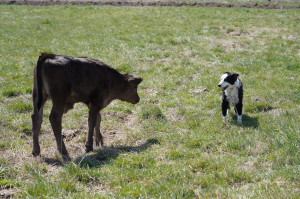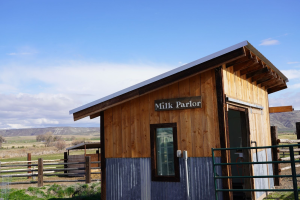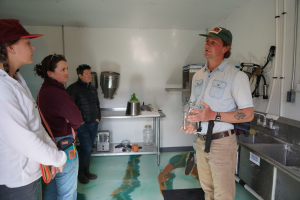“When I’m out there with a cow and I get to see their personality, I’m like, this is precious,” Wilder Jones told ICL staff, who visited Jones on a late April morning at Jones’ Wild Spaces Farm. Jones is fourth-generation Idahoan and third-generation farmer, but the first of his Idahoan lineage to nudge into the dairy industry. Jones takes pride in his work, and even more in his cows; given the delicious array of cheese ICL staff got to sample, he should be proud of what he (and his herd) accomplish. But it’s not all “dream cheese” and homemade butter; Wild Spaces Farm reflects a spectacular amount of strategy, planning, and hard-learned lessons in the world of sustainable, eco-friendly dairy production.
Jones operates his “micro-dairy” out of Glenns Ferry, Idaho, on a piece of land nestled at the foot of the plateaus surrounding Little Canyon Creek. Jones’ fields are intermittently cut by Little Canyon Creek’s wetlands; mallards and herons dive in and out, and red-wing blackbirds take flight between the cattails. In the surrounding pasture, Jones’ herd—several breeds of dairy cow, plus one fuzzy donkey—graze in the sun. His two dogs, Zia and Duchess, roam about the property, checking in on the animals, sniffing out nearby gophers, and demanding pets from visitors like us.

Wild Spaces Farm produces raw dairy products from these organic, grass-fed cows, who live out their days in full access to pasture. Cows raise their calves and never experience confinement. The herd is kept small by design; Jones is constantly asking himself how to keep the operation balanced and minimal. On the one hand, the intimacy of the “micro-dairy” is simply keeping true to the values of Wild Spaces Farm: community, simplicity, a perspective of abundance. On the other hand, it’s pragmatic.
“The way I see it, [mass dairy producers] have caused a lot of their own problems,” Jones explains, using the example of mastitis—an infection of the udder—in confined milking operations. Since Jones produces raw milk (unpasteurized), the health of the cow is consistently assessed and the milking parlor is kept immaculately clean. Under such conditions, Jones very scarcely runs into health troubles with his cows; he’s never seen a case of mastitis, an otherwise near-ubiquitous infection among confined milking cows.

Similarly, the cows’ diet keeps them in good health. While grass-feeding results in lower milk output than grain-feeding, it also results in significantly fewer health issues, as it adheres to the cows’ traditional diet. Additionally, grass-fed manure contains much lower levels of nitrogen and phosphorus, resulting in enhanced water and soil quality.
Jones turns to these examples of natural cycles solving problems—or rather, natural cycles preventing problems before they begin—all across his farm. Waste from the milking parlor is piped into a small pond, where the willow and cattails remediate the waste. Jones has plans to build a greenhouse next door to the parlor, where he will plant bananas and cacao; their aggressive-growing root systems will further help absorb and utilize waste from the milking parlor.
“We don’t allow biology its credit, that it can remediate.” Jones told ICL staff. This idea is central to Jones’ greater farm-ethos of permaculture, which looks to “agriculturally productive ecosystems” that mirror, if not embody, the diversity and balance of natural ecosystems.
Jones made sure ICL staff didn’t go far without an extensive sample of his dairy products: feta, mozzarella-like Oaxacan cheese, yogurt, “dream cheese” (an herbed soft cheese marinated in olive oil), and kefir. When the opportunity for culinary creativity presents itself, Jones takes it; he recently made a cheese with lavender and sagebrush, pulling inspiration from his immediate environment.

“I’m a good cook, but I’m inconsistent. That’s part of the magic of cooking—it’s inconsistent. You can’t always repeat it every single time,” Jones shared while preparing the next round of samples for ICL staff.
Jones brings his goods from Wild Spaces Farm to both Boise and Ketchum Farmers Markets. If you want to learn more about Jones’ work, make sure to visit him at the farmers market and support his business! It’s all delicious, but officially, we recommend the dream cheese; while you snack on it, you can “dream” of the healthy cows, waterways, land, and hard work that produced this cheese.
Stay tuned for our next farm feature story, or sign up for our Snake River Campaign email updates to have it sent directly to your inbox.
